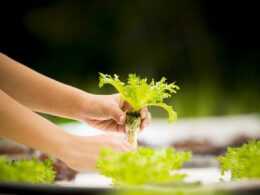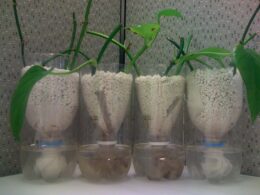Have you ever considered starting a hydroponic garden but wondered if certain plants could not grow in this method? Hydroponic gardening is a popular choice for those who want to grow plants without soil, using nutrient-rich water instead.
However, not all plants can thrive in this environment. It’s important to know which plants can and cannot grow hydroponically before starting your own garden.
In this article, we will explore the basics of hydroponic gardening, including the types of plants that can grow hydroponically, as well as those that cannot. We will also delve into the reasons why certain plants cannot grow in a hydroponic system, and discuss alternative growing methods that might be more suitable for those plants.
By the end of this article, you’ll have a better understanding of what plants can and cannot grow hydroponically, and how to ensure the success of your own hydroponic garden.
Understanding the Basics of Hydroponic Gardening
You’ll gain a comprehensive understanding of the fundamentals of hydroponic gardening, allowing you to cultivate a wide variety of crops using innovative techniques.
Hydroponics is a method of growing plants without soil. Instead, plants are grown in a nutrient-rich solution that provides all the necessary elements for growth. Hydroponic setup involves using a container to hold the nutrient solution, a growing medium to support the plants, and a system to deliver the solution to the plants.
Nutrient solutions are the backbone of hydroponic gardening. They can be tailored to meet the specific needs of different plants. The nutrient solution provides an optimal balance of nutrients, including nitrogen, phosphorus, potassium, and trace minerals.
Plants grown hydroponically can grow up to 50% faster than those grown in soil, and they produce larger yields. Hydroponic gardening is also more water-efficient, using up to 90% less water than traditional gardening methods.
By mastering the basics of hydroponic gardening, you’ll be able to grow a wide variety of crops, including leafy greens, herbs, and fruits. However, there are some plants that can’t grow hydroponically, such as plants that require a lot of space to grow, like pumpkins or watermelons. Additionally, some plants rely on symbiotic relationships with soil bacteria or fungi, which cannot be replicated in a hydroponic setup.
Overall, hydroponic gardening is an innovative and sustainable way to grow plants, and with a little bit of knowledge and effort, you can cultivate a thriving hydroponic garden.
Plants That Can Grow Hydroponically
If you’re interested in growing plants hydroponically, you’ll be glad to know that there are plenty of options available to you.
Leafy greens like lettuce and spinach, as well as herbs like basil and cilantro, are some of the easiest plants to grow in a hydroponic system.
If you’re looking for something a little more substantial, tomatoes, cucumbers, and even strawberries can also thrive in a hydroponic environment.
Leafy Greens
You’re surrounded by a lush garden of leafy greens, their vibrant hues and delicate textures filling your senses.
Growing spinach and kale hydroponically is a great option, as it allows you to control the nutrient requirements for these leafy greens more precisely than conventional growing methods. In hydroponics, you can adjust the nutrient solution to meet the specific needs of each plant, ensuring they grow healthy and strong.
Leafy greens thrive in hydroponic systems, as they don’t require much space to grow and can be grown year-round. In a hydroponic system, you can create the perfect environment for your leafy greens by controlling the temperature, humidity, and light.
A well-designed hydroponic system can yield a high volume of leafy greens with minimal effort, making it an ideal choice for anyone looking to grow their food in a small space.
So, if you’re looking to grow your own fresh and nutritious greens, give hydroponics a try and enjoy the bountiful harvest all year round!
Herbs
Get ready to take your cooking to the next level with a variety of fresh and flavorful herbs, easily grown in a hydroponic system. Growing basil and parsley hydroponically is a beginner’s guide to indoor herb gardening.
Hydroponic systems provide all the necessary nutrients for the herbs to grow, making them healthy and robust. You don’t need a large garden or even a sunny windowsill to grow these herbs. All you need is a small space indoors and a hydroponic system.
The benefits of indoor herb gardening are plenty. You can have fresh herbs at your fingertips all year round, without the need to worry about seasonal changes or weather conditions. You can also save money by growing your own herbs instead of buying them from a grocery store.
With hydroponics, you don’t need soil, so there’s no mess or pests to deal with. Growing herbs hydroponically is not only easy, but it’s also a great way to add flavor and nutrition to your meals.
Tomatoes
You can elevate your homegrown cooking with juicy and flavorful tomatoes, easily cultivated in a hydroponic system.
There are several tomato varieties suitable for hydroponic growth, such as cherry tomatoes, beefsteak tomatoes, and heirloom tomatoes. These varieties thrive well in a hydroponic system because they require less space, fewer nutrients, and less water than traditional soil-based gardening.
However, growing tomatoes hydroponically can present some challenges. Tomato plants need plenty of light, water, and nutrients to grow healthy and produce fruit. It’s crucial to monitor the pH level of the nutrient solution regularly and adjust it accordingly.
Additionally, tomato plants need adequate support as they grow taller and heavier. With proper care and attention, you can enjoy a bountiful harvest of delicious, homegrown tomatoes right in your home.
Cucumbers
The next crop to consider in your hydroponic system is cucumbers, which can easily thrive in this environment. There are multiple cucumber varieties that can be grown hydroponically, such as English, pickling, and Armenian cucumbers.
Not only do they add a touch of freshness to your diet, but they also grow quickly and can produce high yields. However, there are some challenges faced when growing cucumbers hydroponically.
One of the main challenges is maintaining the proper nutrient balance in the water solution. Cucumbers require high levels of potassium and nitrogen to grow, which can be difficult to maintain in a closed hydroponic system. Additionally, compared to soil grown cucumbers, hydroponic cucumbers may require more attention and maintenance.
But with the right techniques and care, you can easily overcome these challenges and enjoy fresh cucumbers all year round.
Strawberries
If you’re looking to add a touch of sweetness to your hydroponic garden, consider growing strawberries. These delicious fruits are not only tasty, but they’re also easy to grow hydroponically.
When it comes to growing techniques, strawberries can be grown using the nutrient film technique (NFT) or the drip irrigation method.
In terms of soil requirements, strawberries don’t actually need soil at all. Instead, they can be grown using a growing medium such as coconut coir or perlite. However, it’s important to note that strawberries do require a slightly acidic pH level of around 5.5-6.5.
By monitoring the pH level and providing the proper nutrients, you can enjoy a bountiful harvest of juicy red strawberries.
Are There Any Plants That Cannot Thrive in a Hydroponic Garden?
Yes, there are certain plants that are not suitable for hydroponic gardens. However, there is a wide range of best plants for hydroponic gardens that thrive exceptionally well. These plants, such as lettuce, spinach, and herbs, have adapted to the soil-less environment and can flourish with the right nutrient balance and hydroponic system.
Plants That Cannot Grow Hydroponically
It’s worth noting that certain types of vegetation simply won’t thrive in a hydroponic environment. While hydroponic systems are great for growing a wide variety of plants, there are some that require soil-based methods for optimal growth.
The challenges faced by hydroponic farmers include finding the right nutrient mix, pH balance, and water quality, which can be difficult for some plants. Plants that require a specific type of soil, such as those that grow in sandy or clay soils, may have difficulty growing hydroponically. These plants have adapted to their specific soil type and may not receive the necessary nutrients from a hydroponic system.
Additionally, root crops such as carrots and potatoes may not grow well in a hydroponic environment, as they require a lot of space for their roots to spread out. Certain types of trees, such as oak and pine, also cannot grow hydroponically. Trees require deep soil for their roots to grow and anchor them in place. While it may be possible to grow a small tree hydroponically in a controlled environment, it would not be practical for large-scale production.
In general, plants that have evolved to grow in soil will struggle to thrive in a hydroponic system, and it’s important for farmers to choose the right plants for their setup.
Reasons Why Certain Plants Cannot Grow Hydroponically
Not all types of vegetation can thrive in a hydroponic setup due to their specific soil requirements and difficulty in obtaining the necessary nutrients and pH balance.
Pineapple growth is an example of a plant that cannot be grown hydroponically due to its reliance on soil for nutrients. Pineapples require a lot of potassium, which is difficult to maintain in a hydroponic system without the use of chemicals.
Soil nutrient dependency is another reason why certain plants cannot grow hydroponically. Many plants require specific nutrients found in soil, such as iron or magnesium, that are not easily replicated in a hydroponic system. Without these nutrients, plants will not grow properly or may not grow at all.
This is why it’s important to research the specific needs of each plant before attempting to grow them hydroponically.
In conclusion, while hydroponic growing has many benefits, it’s important to note that not all plants can thrive in this environment. Pineapples and other plants with a high soil nutrient dependency may struggle to grow without the proper nutrients and pH balance. It’s important to research the specific needs of each plant to determine if it’s suitable for hydroponic growing.
Alternative Growing Methods
You can explore other growing methods that may be more suitable for certain types of vegetation, allowing for a diverse array of plants to be grown and harvested. One such method is vertical farming, which involves stacking layers of plants on top of each other in a controlled environment. This method allows for a higher yield of crops in a smaller space, making it an ideal option for urban agriculture.
Another alternative growing method is aeroponics, which involves growing plants in a mist environment without the use of soil. Instead, the plants are suspended in a chamber and nutrient-rich mist is sprayed onto their roots. This method allows for faster growth and higher yields, as well as reducing the amount of water needed compared to traditional soil-based farming.
By exploring these alternative growing methods, you can expand the range of plants you can grow hydroponically. These methods are not only efficient but also sustainable, and they allow for a more diverse and healthier food system. So if you’re looking to grow a wider variety of crops, consider exploring vertical farming and aeroponics as alternative growing methods.
Frequently Asked Questions
What is the cost difference between hydroponic gardening and traditional soil-based gardening?
When it comes to gardening, many people wonder if hydroponic gardening is worth the cost. Cost comparison between hydroponic gardening and traditional soil-based gardening largely depends on the yield efficiency of the plants.
Hydroponic gardening can be more expensive upfront due to the equipment and materials needed, but it can also result in higher yields and faster growth. Traditional soil-based gardening may have lower initial costs, but it requires more maintenance and can be affected by weather conditions.
Ultimately, the cost comparison between the two methods depends on your individual needs and preferences.
How long does it take for plants to grow in a hydroponic system compared to soil-based systems?
If you’re wondering about the growth rate of plants in hydroponic systems compared to soil-based systems, you’ll be happy to know that hydroponic growth rate is actually faster due to the increased nutrient uptake.
In fact, plants can grow up to 50% faster in hydroponic systems! This is because the nutrients are directly delivered to the roots, allowing plants to absorb them more efficiently.
Plus, hydroponic systems can be controlled more precisely, allowing for optimal growing conditions. So, if you’re looking for a faster and more efficient way to grow plants, hydroponics may be the way to go.
Can herbs and spices be grown hydroponically, or do they require soil for optimal growth?
Hydroponic herbs and soilless spices can have optimal growth without the need for soil. In fact, they can be grown faster and with less environmental concerns compared to traditional gardening methods.
Hydroponic systems can also save on costs and space, making it easier for people to grow regional fruits and cold weather vegetables all year round. With a shorter growth time, you can enjoy fresh herbs and spices in your dishes sooner.
Plus, hydroponics can provide a safer and cleaner way to grow produce as there’s no need for pesticides or herbicides. So, if you want to enjoy the benefits of fresh herbs and spices without the hassle of traditional gardening, try growing them hydroponically!
Are there any environmental concerns associated with hydroponic gardening, such as water usage or waste production?
When it comes to hydroponic gardening, there are some environmental concerns to keep in mind.
Water conservation is key, as hydroponics systems require a constant flow of water to keep plants healthy.
You’ll also need to be mindful of nutrient runoff, which can occur if you use too much fertilizer.
To prevent this, make sure you’re using the right amount of nutrients and regularly test your water to ensure it’s not becoming too acidic.
By taking these steps, you can enjoy the benefits of hydroponic gardening while minimizing your impact on the environment.
Can hydroponic systems be used to grow fruits and vegetables that are typically only grown in specific regions or climates, such as tropical fruits or cold-weather vegetables?
You may be surprised to learn that hydroponic systems can be used to grow tropical fruits and cold-weather vegetables that are typically only grown in specific regions or climates. These crops can be grown all year round, regardless of the climate outside, making it a great option for those who live in areas with harsh winters or limited growing seasons.
Some popular tropical hydroponic crops include pineapple, passion fruit, and papaya, while cold weather hydroponic crops include lettuce, kale, and broccoli. With hydroponics, you have the ability to grow a wide variety of crops that may not have been possible to grow in your climate before.
Conclusion
Congratulations! Now you know what plants can’t grow hydroponically. Most plants can thrive in a hydroponic system, but there are some exceptions. Plants that have long taproots or require a lot of space to grow are not suitable for hydroponics. These include plants like carrots, potatoes, corn, and pumpkins.
However, just because these plants can’t grow hydroponically doesn’t mean you can’t enjoy them at home. You can still grow them in soil or other alternative growing methods, such as aquaponics or aeroponics. With a little bit of research and experimentation, you can find the best growing method for your favorite plants.
Happy gardening!









